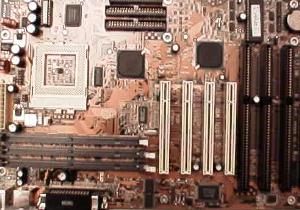| Socket Style: | Socket 7 |
| Chipset: | i82430TX |
| Cache: | 512KB |
| Form Factor: | ATX |
| BUS Speeds: | 50 / 55 / 60 / 66 / 68 / 75 / 83 MHz |
| Clock Multipliers: | 1.5x / 2.0x / 2.5x / 3.0x / 3.5x |
| Voltages Supported: | 2.8 / 2.9 / 3.2 / 3.38 / 3.5 |
| RAM Slots: | 3 168pin DIMM Slots (EDO/SDRAM) |
| PCI/ISA Slots: | 4 PCI Slots 4 ISA Slots (1-Shared / 4-Full Length) |
| BIOS: | AWARD PnP BIOS w/ SeePUTM Jumperless CPU Setup |
| PCI EIDE Controller: | Super I/O 2 EIDE Channels 1 FDD Channel 2 Serial /1 EPP |
 |
Impressed by Chaintech's new TX motherboard design? However are you finding that the AT layout of the 5TDM2 is just too cramped for you? In that case the 5TTL is what you need, provided you don't have any old 72-pin SIMMs laying around. The 5TTL features the standard 4 PCI / 4 ISA slots configuration laid out spaciously on the ATX form factor of the motherboard. As mentioned earlier, this entry by Chaintech provides the user with a full 3 DIMM slots for memory expansion, and nothing else. The motherboard complies fully to the ATX specification, placing the Socket-7 IC (Integrated Circuit) directly in the path of the ATX PS Fan. |
The 5TTL's Socket-7 IC differs from that of many other motherboards in that the center of the physical socket is home to a thermal sensor, therefore enabling the 5TTL's System Monitoring and Alert features for the CPU installed. The easy to configure AWARD PnP BIOS Setup of the 5TTL allows the user to monitor the CPU's current temperature as well as set a warning alarm if the temperature exceeds a user defined limit. The BIOS Setup is also home to Chaintech's patented SeePUTM technology which is a Jumperless CPU Configuration Utility much like ABIT's SoftMenuTM setup. From the Chipset Features setup in the AWARD PnP BIOS utility the user is allowed to select from a list of pre-defined CPU settings in order to expedite the installation/configuration process. However the user also has the option of enabling the User's Favorite setting in the SeePUTM setup which allows you to manually select the bus speed, clock multiplier, and core voltage settings for your configuration. The Bus speeds available range from 50 - 83.3MHz including the turbo frequency of the 66MHz bus speed (68MHz) and the clock multipliers the user has to choose from cover the standard 1.5x - 3.5x.
Like the other two new Chaintech TX motherboards, the 5TTL allows you to switch among two different CPU settings on-the-fly! If the user enters in the following keystroke combination while the computer is running: [CTRL][ALT][-] the motherboard will automatically put the CPU into a de-turbo mode, which is incredibly useful especially when running those old 286/386 programs on your new high speed Socket-7 system. By striking [CTRL][ALT][+] the motherboard is placed back into the turbo mode so you can return to your computer to its normal operation state.
Chaintech's manual is of course a first class manual, with its only major competitor being ABIT, naturally. The strongpoint of Chaintech's manual happens to be its excellent description of the possible BIOS settings of the 5TTL, the individual descriptions are aided greatly by accurate screen shots of the AWARD BIOS interface. Since the motherboard is jumperless, and since the manual is a very well written document, initially setting up and using the 5TTL should be a breeze even for a first time system builder.
Like the 5TDM2, the stability of the 5TTL is excellent at most clock speed settings, with the exception of the 290.5MHz setting for the Pentium MMX, and the 250MHz+ settings for the AMD K6 due to a lack of high quality Sanyo capacitors mostly, and also encouraged by the limited core voltage settings in the SeePU Setup Utility. Performance wise the 5TTL is just about on par with the 5TDM2 with the performance difference being about 0.1 - 0.3 Winstone points in all tests, a margin just about the size of a standard Winstone margin of error. As far as the end user is concerned, the 5TTL is just as fast as the 5TDM2.
Unfortunately the 5TTL is plagued by the same problems mentioned in the 5TDM2 review:
As mentioned earlier, the SeePUTM Jumperless CPU Configuration utility only allows you to select from a limited amount of core voltage settings for your CPU. This makes overclocking on the 5TTL a bit of a chore if you plan on increasing the clock speed beyond 25%, and in some cases even beyond 10%! For example, with the Pentium MMX you are limited to at MOST a 2.9v core setting, which unfortunately doesn't cut it at 290.5MHz (83.3 x 3.5) although it is perfectly ok at 262.5MHz.
Again, like the 5TDM2, the long term reliability of this motherboard is questionable due to the lack of high quality Sanyo-tantalum capacitors, and as most people would agree, those high quality capacitors are almost a requirement for operation out of spec, in other words "serious-overclocking."










0 Comments
View All Comments